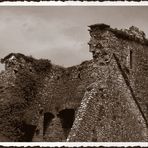Aughnanure Castle, County Galway
The "ferocious O'Flaherties", masters of the whole territory of west Connaught, built this fine castle in the early sixteenth century, possibly on the site of a thirteenth-century Norman fortification. It occupies a position of some strength close to Lough Corrib on what is virtually a rocky island formed by the Drimmeen River, separating into two branches and reuniting at the other side - a circumstance that gave rise to the old phrase "Aughnanure, where the salmon come under the castle".
A natural bridge of rock gives access to the inner bawn and tower house on the west, while an extensive outer bawn lies to the east and south. The well-built six-storey tower has a gracefully battered base and two flanking bar tizans at mid-height, which impart to the castle a very picturesque appearance. It has a vault over the fourth storey with the hall on the fifth storey, where there is a large fireplace and wide mullioned windows. A good fire place on the third storey indicates that this was the lord's suite, while the second, fourth and sixth storeys formed sleeping accommodation for the family and servants. In the thickness of the east-end wall there is a tier of mural chambers and a spiral stair giving access to all floors. An unusual defensive feature are the internal loopholes on the two walls of each landing of the stair. At the top a door leads to the wall walk and a modern hipped roof, whose parapets have machicolations on all four sides and com mand a wonderful view over Lough Corrib.
Aughnanure is unusual in having a double bawn. Its riverside walls have survived, but the east and south-east inner curtain-walls have gone, leaving a round flanker isolated on the south-east side. The outer ward has a similar flanker on the south-east corner, while to the west stands one wall of the castle's once splendid banqueting hall. The outer wall of this building has collapsed into an underground tributary river (now dry as its course has been changed), but its pretensions to style are evident from the carvings on the soffits of the window embrasures depicting elaborate vine leaves and clusters of grapes in low relief.
The castle was the seat of the O'Flaherty chiefs until 1572, when it was captured by Sir Edward Fitton, Presi dent of Connaught, and delivered to a junior member of the clan who had been enticed over to the Crown. Its position at the head of the lake allowed the castle to play an import ant role in the Cromwellian blockade of Galway, but afterwards it was forfeited and granted to the Earl of Clanrickard. Somehow the O'Flahertys remained in resi dence and in 1719 regained ownership, but later the castle passed to Lord St George on the foreclosure of a mortgage. In the nineteenth century a member of the Leconfield branch of the O'Flahertys planted yew trees about the castle to perpetuate its Gaelic name - the field of the yews.
Located 2 miles SE of Oughterard on a minor road E of the main Galway road.
Wer sich in Irland auf die Suche nach Burgruinen machen möchte, die weniger touristisch erschlossen sind, dem lege ich die beiden folgenden Bücher nahe:
The Shell Guide to Ireland (ISBN 0-7171-2310-3) und
National and Historic Monuments of Ireland (ISBN 0-7171-1956-4)
Mit diesen Büchern ist es möglich, auch die versteckten Geheimnisse Irlands zu finden ;-)
Hintergrundinfos zu den Burgen Irlands finden sich in dem hervorragenden Buch "Castles of Ireland" von Brian de Breffny (ISBN 0-500-27398-7)
Auch sehr empfehlenswert ist eine Website:
http://www.irelandseye.com
Kamera: Nikon F90x
Objektiv: Nikon AF Nikkor 28-105mm
Film: Agfa Crome CTx100
Frühjahr 2001
Weitere irische Burgen in meinem Fotohome:

carpeta Irland in Sepia
(36)
http://www2.fotocommunity.de/pc/pc.php4?pcat=727










IP Eyes 13/02/2003 9:41
Diese s/w Bilder find ich super faszinierend.LG, Ina
FotoMiru - Michael Ruthenbeck 05/06/2002 23:10
Genial ! Du kommst vielleicht rum....Gruß Michael
Kurt Salzmann 03/06/2002 13:47
Schönes Bild sw gefällt mir besonders.